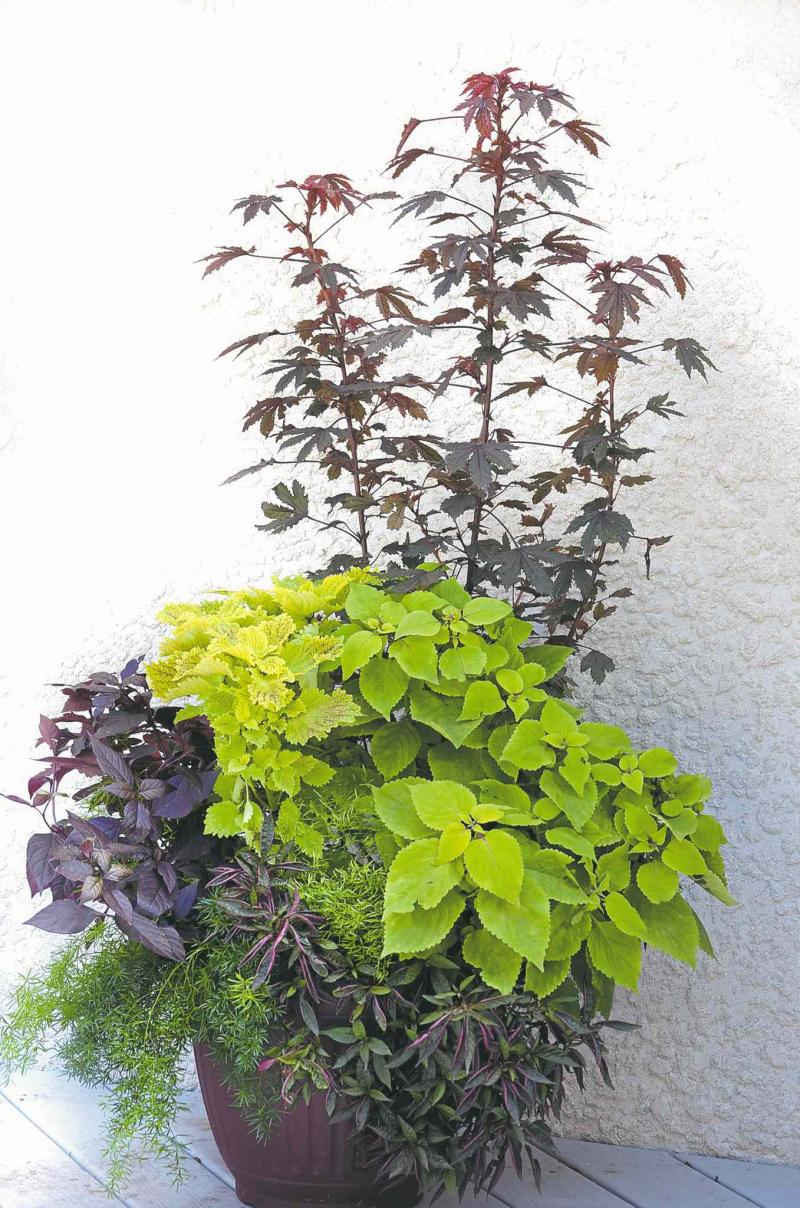
You know the drill. Once fall arrives, it's time to clean up debris around plants, destroy any diseased plant material and be sure to water your beds deeply so plants aren't going into winter without adequate moisture. Containers, too, need to be emptied, cleaned and stored for the winter.
The motivation to complete fall tasks isn't easy to find when there is still the promise of sunny, sleeveless afternoons. In my garden at this late date in September the delphiniums and speedwell are well past their prime but summer flowering perennials such as daisies and phlox are enjoying a second flush of blooms. Roses, too, are still blooming and some of the container displays seem too lovely to take apart. Still, it's the time of year when local gardeners need to keep their eyes on the calendar and the inevitability of a Manitoba winter.
Last November there were few of us who didn't suffer losses of favourite plant varieties when temperatures fell rapidly to -25C without the benefit of an insulating snow cover. Could bitterly cold temperatures arrive again before enough snow has fallen to protect the crown and roots of our perennials? Alternate freeze-thaw cycles, too, that can occur in late winter causing plants to heave, breaking their roots, result in death or injury as well.
Replacement of plants in springtime can be costly. What will you do to prevent plant losses this winter? My usual strategy is to leave most of my perennials standing and to mulch around plants using shredded leaves once the soil has frozen.
Come November, though, if there is only a minimum of snow cover, I plan to mulch tender plants with 20 centimetres of flax straw for added winter protection. In spring, shredded leaves are easy enough to remove or can be used as a mulch for the growing season. Flax straw, though, must be removed and can be a messy task. It will be well worth the effort if the plants all survive.
What else are gardeners doing this fall? Fall is a great time for planting bulbs. Deborah Petrie, past president of the Manitoba Regional Lily Society, currently has pre-dug holes in her garden awaiting her last purchases at upcoming bulb sales. "I always keep the garden soil from my pre-dug holes in tubs in the garage," says Petrie, "so it doesn't freeze. I use it to fill in the pre-dug holes after popping the bulbs into them." On existing lilies, Petrie waits until the stems and leaves die after the first frost before she cuts off the above ground portion. "Since the stems feed the bulbs this gives the bulb a chance to plump up for the next spring's growth," she says.
Linda Dietrick takes cuttings from a long list of plants such as coleus, iresine, oxalis, setcreasea and a trailing succulent, Dorotheanthus bellidiformis, more easily pronounced as Mezoo. In mid to late September, Dietrick selects healthy young lateral shoots, about 10 to 13 cm, and snips them off with clean scissors. Removing any flowers, she collects the cuttings in a plastic container of water and rinses each one under cool running water to ensure there are no hitchhikers such as mealy bugs or spider mites. Next, using a sharp, perfectly clean knife, she prepares the stems for rooting by first removing the top three pairs of leaves from each stem.
After cutting the lower end of the stem at an angle just below a leaf node, Dietrick places a single cutting into a glass bud vase then keeps it on the sunny windowsill over her kitchen sink. Dietrick says it's possible to put as many as six cuttings into one vase although the water level depletes more rapidly.
Low light conditions prevail indoors especially during the winter months, however the amount of light that comes in through the window combined with a fluorescent light fixture directly above that is left on 24 hours a day ensures that the cuttings receive enough light. "Don't change the water," says Dietrick who just replenishes with fresh water. After a short while, small roots begin to form and emerge, sometimes from the bottom of the stem or the area around the nodes. Coleus roots in two to three weeks. "It's really quite amazing," says Dietrick. Once she is satisfied with the amount of rooting, she pots up three or four cuttings into a 15cm plastic nursery pot filled with sterile, soilless potting mix. Dietrick is careful to not overwater the plants, using her finger to check first that the soil is still dry two to three cm down before she waters.
Between January and March, Dietrick repeats the process by taking a second set of cuttings and these become the ones that will be planted in her garden in the spring. Dietrick takes cuttings from six or eight favourite coleus varieties, not all of which may be available in spring at garden centres. A thrifty gardener, she says it is rewarding to take cuttings from easy to root plants such as Purple Heart setcreasea, Molten Lava oxalis, and especially Purple Lady iresine.
In August I dropped into the St. Vital Agricultural Society's annual fair and marvelled at the beauty of Val Johnson's foliage container. Winner of first prize in the Leaf it to Nature category, Johnson's container display consisted of plants that she grew from cuttings, except for one, asparagus fern. The other plants, all annuals, included Mahogany Hibiscus, a statuesque plant with foliage that resembles that of Japanese Maple, as well as Royal Tapestry and Purple Knight alternanthera, Velvet Mocha coleus, and a dark green coleus with burgundy stems.
Once again, Johnson has taken cuttings from these plants. She says she has never had luck rooting cuttings in water and prefers to root them in 5cm pots filled with moistened soilless potting mix. She places the pots in a tray on top of a heating mat then covers the tray with a plastic cover. Within a few days, says Johnson, the annuals have begun to root. In October she repots them into 10 cm pots and keeps them in her laundry room under fluorescent lights for 12 hours a day. In January or February, Johnson pinches the plants back to encourage branching and sometimes takes additional cuttings if she wants more of something.
Last fall Jeannette Adams took cuttings from Indian Dunes geranium and brought them indoors. The cuttings grew so prolifically that she took more cuttings in late winter and started several plants for her summer containers. Indoors the unique colour of Indian Dunes faded somewhat but this summer, in natural sunlight, the plants positively flourished.
Maggie McNaught purchased two hardy hydrangeas in the spring and grew them in large ceramic pots for the summer. Now she plans to overwinter them in their containers inside a separate heated utility garage on her property. Equipped with grow lights, the interior of the building does not go below 4 degrees Celsius. McNaught has successfully overwintered two Birds of Paradise plants in the same manner for the past two years. She waters moderately once a week during the winter and says that the plants thrive on neglect.
Kelley Liebzeit grew Silver Sage from seed last winter. A spectacular non-hardy silvery grey biennial with huge, downy soft scalloped leaves, Silver Sage is unsurpassed when planted at the front of a border, raised bed, or container. It survived the winter in Liebzeit's garden a few winters ago. This year she plans to mulch her Silver Sage plants and if any survive the winter and flower next growing season, Liebzeit plans to collect the seeds.
Plants that naturally self-seed take the work out of creating new additions for your garden. Verbena bonariensis and Toto rudbeckia are two of my favourite self-seeding plants. There is no better display of both these plants than the flower bed directly beneath the front window at Jensen's Nursery.
Since fall is when Verbena bonariensis and rudbeckia really shine, Susan Jensen waits until the seed heads ripen then assists the seeds on their way to the loamy soil beneath by scattering them by hand throughout. The result is a reliable, breathtaking display each fall.
colleenizacharias@gmail.com
Notice:
Today from 9 a.m. to 4 p.m. at the Assiniboine Park Conservatory, the Manitoba Regional Lily Society (MRLS) hosts its fall bulb sale. Choose from a seldom seen selection of rare heritage and historic lilies. The MRLS will also host bulb sales in Brandon on Oct. 3 at the Central Community Centre and in Dauphin on Oct. 10 at the Market Place Mall.



